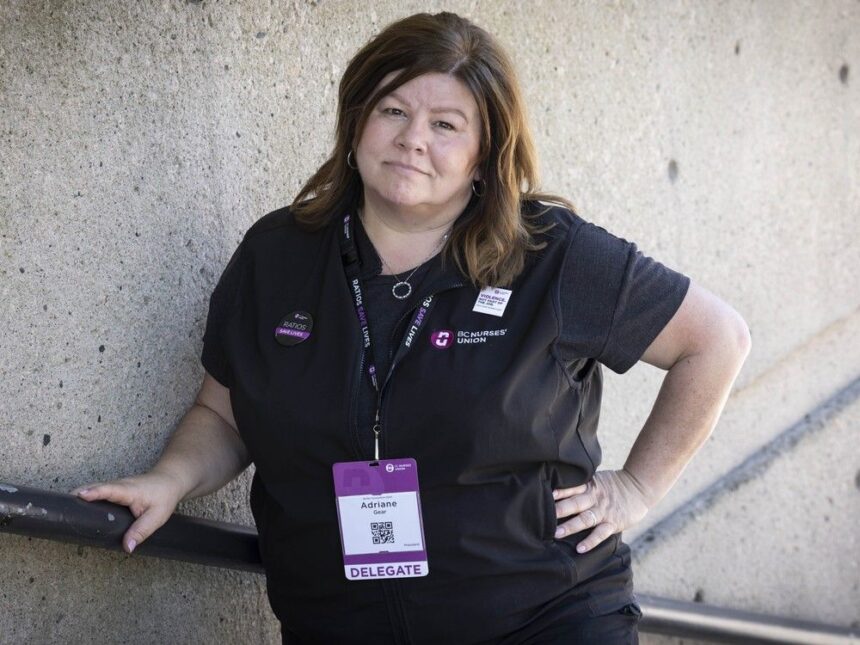As I stood in the bustling emergency room of Surrey Memorial Hospital, the tension was palpable. Nurses moved with practiced efficiency, but their sidelong glances toward the entrance revealed an undercurrent of vigilance that spoke volumes. “We’re always watching the doors,” confided Meena Kooner, an emergency department nurse of seven years. “It’s not just about caring for patients anymore—it’s about surviving your shift.”
Last month, a patient in crisis threw a chair that narrowly missed Kooner’s head. This wasn’t an isolated incident but part of a disturbing pattern affecting healthcare workers across British Columbia. According to the BC Nurses’ Union, reported incidents of violence against nurses have increased by 37% since 2019, with emergency departments and mental health units bearing the brunt of assaults, threats, and harassment.
“I became a nurse to help people through their worst moments,” Kooner told me, adjusting her ID badge which now comes with a panic button attachment. “But I never signed up to be someone’s punching bag.”
The normalization of violence in healthcare settings has reached a critical point. During a recent press conference, BCNU President Adriane Gear called the situation “absolutely unacceptable,” emphasizing that violence cannot be treated as an inherent occupational hazard for healthcare professionals.
“Many nurses come to work fearful of what they may face,” Gear explained as we spoke at the union’s Vancouver office. “Some have suffered career-ending injuries. Others live with post-traumatic stress that follows them home every night.”
What makes this crisis particularly insidious is how violence has been normalized. When I reviewed incident reports, I found numerous cases where nurses didn’t file formal complaints because they considered being hit, spat on, or verbally abused “just part of the job.” This mindset, according to Dr. Farinaz Havaei, a nursing workforce researcher at UBC, represents a dangerous cultural acceptance that perpetuates the problem.
“Healthcare institutions have inadvertently created systems where violence is tolerated as an operational reality,” Dr. Havaei explained during our interview. “This tolerance has serious consequences for both the wellbeing of healthcare providers and the quality of care they can deliver.”
Her research demonstrates that nurses experiencing workplace violence are more likely to make medication errors, provide delayed care, and ultimately leave the profession—a devastating outcome during a provincial nursing shortage already straining the system.
At Royal Columbian Hospital in New Westminster, security measures have been enhanced after several high-profile incidents, including one where a nurse was punched repeatedly by a patient in psychological distress. Now, security guards patrol emergency waiting areas, and some units require key-card access. But many frontline workers tell me these measures remain insufficient.
“We need more than just security guards,” said Jamie Wilcox, a psychiatric nurse with 15 years of experience. “We need comprehensive violence prevention training, proper staffing levels, and leadership that treats each incident with the seriousness it deserves.”
The province has acknowledged the problem. Health Minister Adrian Dix recently announced a $2 million investment in violence prevention initiatives across BC hospitals. However, critics argue this falls short of addressing structural issues that create volatile environments in the first place.
Overcrowding, extended wait times, staff shortages, and the ongoing mental health and addiction crises all contribute to a pressure-cooker atmosphere in healthcare facilities. When I visited Victoria General Hospital’s emergency department during a particularly busy evening shift, patients had been waiting for up to eight hours, with frustration visibly mounting among those still in the waiting room.
“When people are in pain, frightened about their health, or experiencing psychological distress, those long waits can trigger aggressive behavior,” explained Dr. Shannon McDonald, Deputy Provincial Health Officer. “It’s not an excuse for violence, but understanding these triggers helps us develop more effective prevention strategies.”
The solutions being proposed are multifaceted. The BCNU is advocating for mandatory violence prevention training for all healthcare staff, improved incident reporting systems, better environmental design of healthcare spaces, and consistent staffing levels that ensure nurses aren’t working alone in vulnerable areas.
Some hospitals have implemented Code White response teams—specialized groups trained to de-escalate potentially violent situations. At Nanaimo Regional General Hospital, where this approach has been prioritized, reported incidents decreased by 23% over a six-month period.
For nurses like Sam Humphrey at BC Children’s Hospital, these measures can’t come soon enough. “I’ve been grabbed, kicked, and threatened,” Humphrey shared as we walked through the unit where he works. “But what hurts most is feeling like leadership doesn’t take it seriously until someone gets seriously injured.”
Indigenous nurses face additional layers of complexity, often experiencing both patient violence and systemic racism. “As an Indigenous nurse, I sometimes face aggression from patients who don’t want me to care for them,” explained Denise Williams, who works in northern BC. “Then when I report incidents, I’m not always taken as seriously as my non-Indigenous colleagues.”
Addressing these intersecting issues requires acknowledging that violence in healthcare isn’t just a workplace safety issue—it’s a societal one. When I spoke with families of nurses affected by workplace violence, I heard stories of changed personalities, strained relationships, and the ripple effects of trauma that extend far beyond hospital walls.
As our healthcare system grapples with multiple crises, the protection of those who provide care must become a non-negotiable priority. The tolerance of violence against nurses—professionals who dedicate their lives to healing others—reflects a troubling disconnect in our social values.
“We need to shift the narrative,” Gear emphasized as our conversation concluded. “Violence is not acceptable in any other workplace—why should healthcare be different? When you protect nurses, you protect patients too.”
As I left Surrey Memorial that evening, I watched Kooner and her colleagues prepare for the night shift ahead, checking security protocols and supporting each other with quiet determination. Their resilience was remarkable, but it shouldn’t have to be. The time has come for that resilience to be matched by systemic change that ensures no nurse ever accepts violence as simply part of the job they signed up for.






